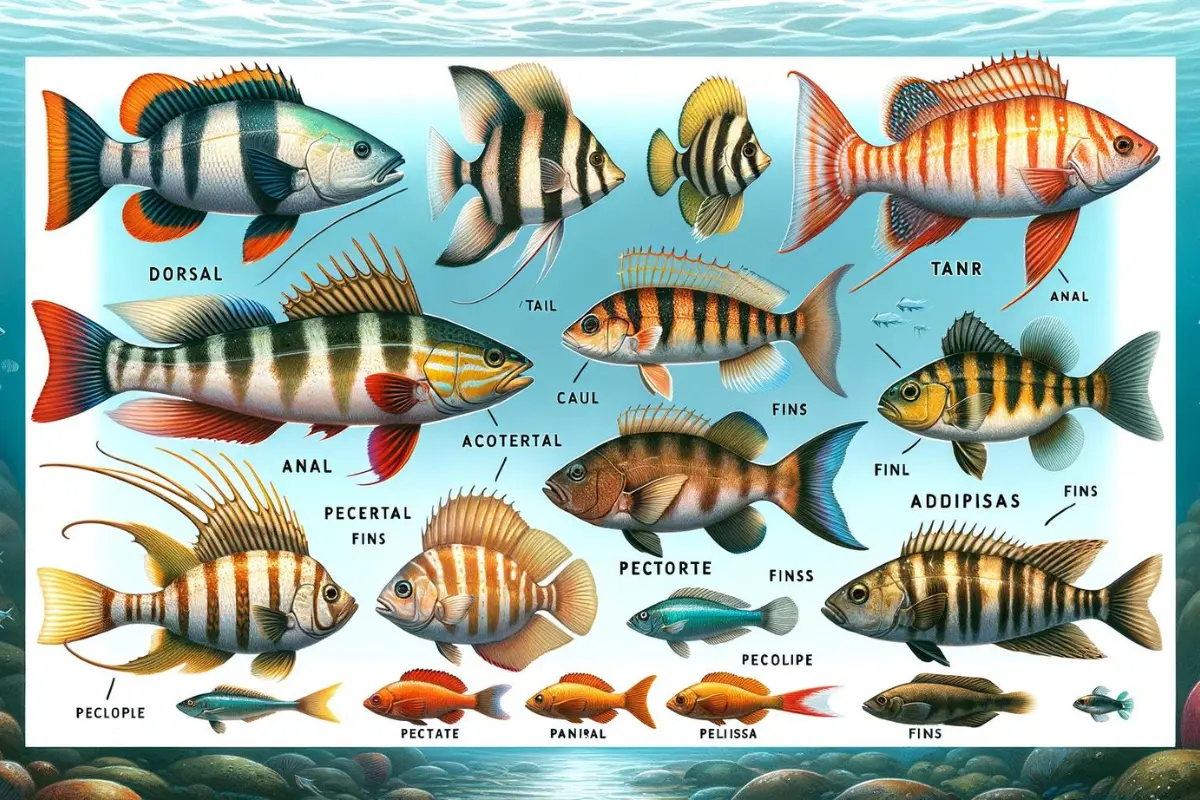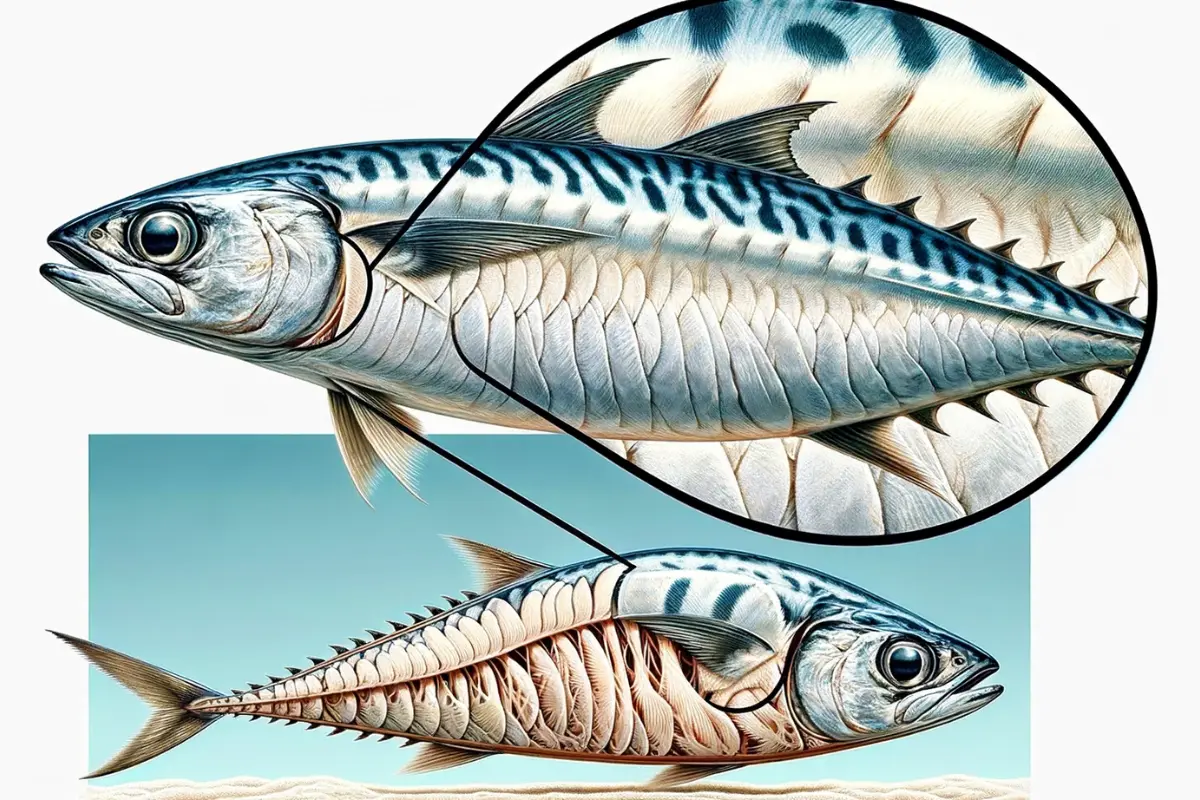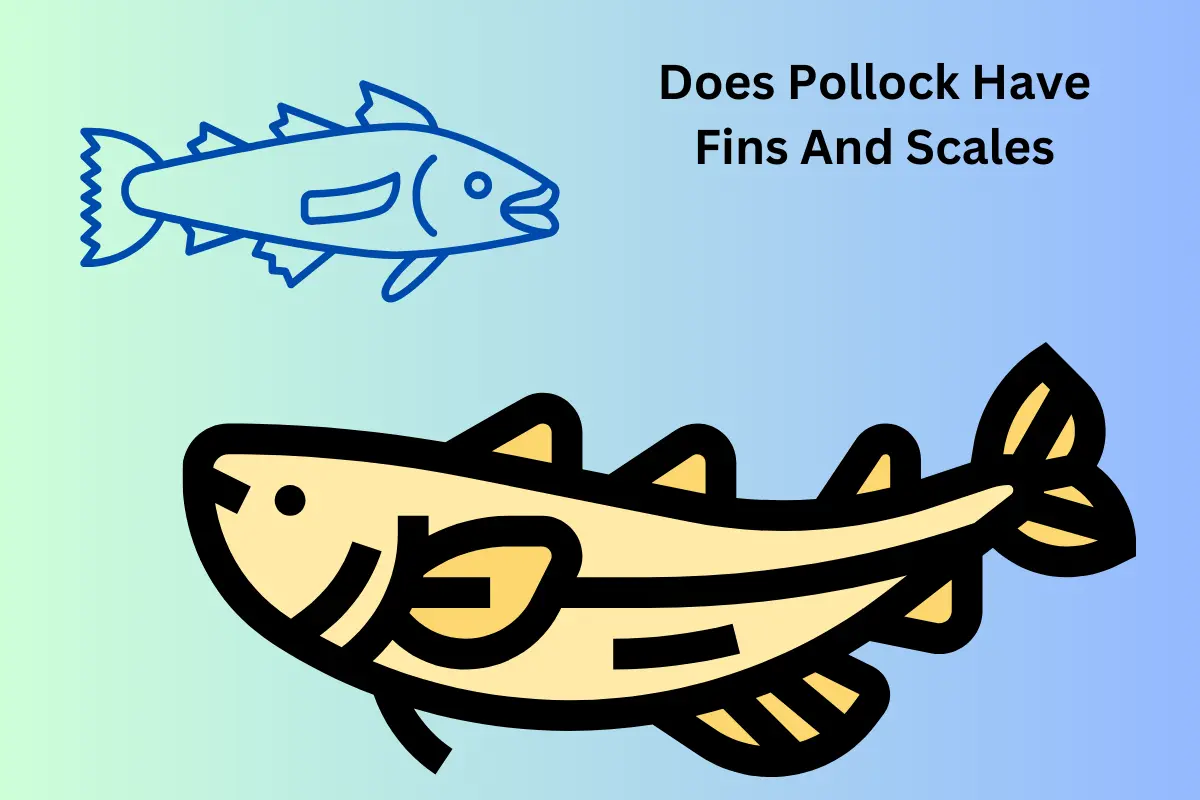Different types of fins, such as dorsal fin, tail fin, anal, pectoral, adipose, and pelvic fins, can be seen in fish. The pelvic and pectoral fins are paired, while dorsal anal and caudal or tail fins are unpaired fins.
Each of the fins has distinct and crucial roles. The dorsal, anal, and pelvic fins provide stability and help in steering while swimming. Pectoral fins are used to go up, down, backward, and forward during swimming. Caudal fin is used for propulsion. Adipose fin contributes to reducing drag and improving swimming efficiency.
Every fish has fins, and it plays a crucial role in their survival. Not all fish have all types of fins. For instance, adipose fins are not very common except for salmon and catfish.
What are the 6 types of fins?
| Fish Fins | Appearance | Function |
| Dorsal fin | Tall, often triangular on back | Providing stability and helping in steering. Also, helps them look bigger than their size. |
| Adipose fin | Small, fatty fin on the back | Reduces drag and improves swimming efficiency |
| Caudal fin | Large, tail fin for propulsion | Primarily for propulsion, determining the speed and direction of movement through water efficiently |
| Pelvic fins | Paired fins near the abdomen | Aid stability and pitch control in fish locomotion |
| Pectoral fins | Paired fins on each side | Assist fish in steering, balance, and overall maneuverability |

Dorsal Fin
The dorsal fins are located on the back of the fish. It is the most commonly seen fin among all kinds of fishes. The number of dorsal fins can vary across different fish species. Some fish may have one dorsal, while some can have two or up to three dorsal fins.
The top fin you can see in sharks is also a dorsal fin. Sailfish, macabre, sunfish, siamese, etc., also have big dorsal fins like sharks.
The functions of dorsal fins include the following:
- The fin helps fish maintain stability and prevent rolling or tipping
- It assists in steering and maneuvering through water
- Some dorsal fins contain blood vessels that aid in temperature regulation. It is important for fish to adapt to various areas of water.
- The dorsal fin makes some fishes look bigger. The fin is also used for defense against predators.
- Dorsal fins may contribute to the overall hydrodynamics of the fish. It reduces the drag of water and helps fish swim faster.
Adipose fin
The adipose fish is a small, rayless, fleshy fin. The fin is not available in most fishes. Some fish species, such as salmon and catfish, have the anterior of the caudal fin. It makes the fin a unique feature of salmon and catfish.
- Adipose fin assists in maintaining buoyancy by offering additional surface area
- Adipose fins can also contribute to the stabilization of the fish. Salmon and catfish especially use the fish during sudden changes in their direction and velocity.
- Some recent studies suggest that these fins serve as a “precaudal flow sensor” that improves their maneuverability.
Caudal fin
The caudal, an unpaired fin, is the tail fin of a fish and is located at the end of the body. It is a common feature of all fish. The exact shape and size of the caudal fin vary among species. The tail can be forked, lunate, round, truncated, or emarginate.
| Caudal Fin Shape | Example Fish | Description |
| Forked | Tuna, Sailfish, Mackerel | Split into two distinct lobes for speed and agility |
| Lunate | Sharks, Swordfish, Marlins | Crescent-shaped for efficient, sustained swimming |
| Round | Goldfish, Carp, Catfish | Circular shape for stability and maneuverability |
| Truncate | Bass, Pike, Trout | Straight-edged, balancing speed and maneuverability |
| Emarginate | Salmon, Walleye, Snapper | Slightly indented, a compromise between speed and agility |
The caudal fin plays some important roles in fish life. For example,
- The fin is used to gain the necessary power to move forward.
- Caudal fins often act like a rubber that fish use for steering
- Different shapes of the caudal fin provide different maneuverability for different fish
- Like other fins, caudal fins also contribute to maintaining stability and balance.
Pelvic fins
Pelvic fins are paired fins and are located on the lower side of a fish. They are positioned just behind the pectoral fins. Pelvic fins can be of different shapes, too. Here is a list of different types of fins and fishes that have them.
| Pelvic Fin Shape | Description | Example Fish |
| Fan-shaped | Broad and rounded, aids in stability and steering | Gobies, Darters |
| Filamentous | Elongated and thread-like, may assist in precise movements | Angelfish, Surgeonfish |
| Pointed | Sharp and pointed, designed for agility | Trout, Salmon |
| Adhesive | Fused and flattened, used for attachment to surfaces | Catfish, Suckermouth Fish |
| Spatulate | Spoon-shaped, contributing to lift and stability | Flounder, Skate |
- Pelvic fins assist in maintaining the fish’s balance
- They play a role in controlling direction during swimming
- These paired fin sets help adjust the fish’s angle in the water. Fish can adjust the position and movement of its pelvic fins. They manipulate these fins to change their pitch or angle relative to the horizontal plane.
- Some species, such as angelfish, gobies, or surgeonfish, use pelvic fins for fine-tuned maneuvers
- The positioning and angling of pelvic fins also contribute to the lift during swimming. The pelvic fins generate life by directing water downward and creating an upward force.
Pectoral fins
Pectoral fins are paired fins located on each side of a fish, near the gills. These fins have a broad and flattened appearance that resembles wings. Gobies, Angelfish, Surgeonfish, Catfish, Trout, Salmon, and many other fish species have pelvic fins. Eels, lampreys, and some species of catfish do not have these fins.
| Pectoral Fin Shape | Description | Example Fish |
| Rounded | Broad and rounded, providing lift and stability | Goldfish, Carp, Sunfish |
| Pointed | Tapered and pointed, aiding in precise maneuvers | Tuna, Flying Fish, Snapper |
| Falcate | Sickle-shaped, contributing to speed and agility | Swordfish, Sailfish, Marlin |
| Filamentous | Elongated and thread-like, used for fine-tuned movements | Lionfish, Angelfish, Butterflyfish |
| Spatulate | Spoon-shaped, assisting in lift and stability | Flounder, Skate, Ray |
- Pectoral fins aid in generating life and helping the fish control its buoyancy in the water
- Pectoral fins also contribute to the fish’s stability, steering, and precise movements.
- The fin is also used for braking. The adjustment of the angle and positioning can slow down or come to a stop. They can spread the pectoral fin forward, and the increased surface area creates resistance against the water.
What are the parts of the fins?
Though different fins have different functions and formations, some of the common parts of fish include rap, base, membrane, etc.
- Ray or spine is the bony or cartilaginous support structure of the fin. It provides rigidity and support. Dorsal fins, anal fins, pelvic fins, and pectoral fins have rays in them.
- The thin, flexible tissue between the rays is called webbing or membrane. It aids in controlling water flow and contributes to the fin’s function.
- The attachment point of the fin to the fish’s body is base. It connects the fin to the body muscles and helps in movement and control
- The front edge of the fin that faces the direction of movement is the leading edge. It often plays a role in providing lift and stability.
- Another common part of fins is the trailing edge. It is the rear edge of the fin. It helps control water flow and contributes to the fin’s overall function.
FAQs
What animals have fins?
Fish are the most common animal with fins. They have dorsal, pectoral, pelvic, and anal fins. Some other marine mammals, such as dolphins and whales, have flippers that resemble fins.
Can You Eat Fins?
The caudal fins of different fish can be eaten after boiling. It has some meat and juice to offer. The other types of fins are usually not eaten. They do not have any meat on them and are often not suitable for digestion.
Do fins contain bones?
No, fish fins do not contain bones, except for lungfish and the coelacanth. The fins are supported by rays, which are made of cartilage and thin bony elements. The lack of bones in fins gives them flexibility and allows for controlled movements in the water.
Can a fish swim without fins?
Yes, fish can swim without the help of fins. However, the fins help them maintain stability and balance. Some fins are used for steering and braking. The absence of fins can make it difficult for them to swim efficiently, but they can swim without them.
Can fish regrow fins?
Yes, fish can regenerate certain body parts, including the fins. They can regenerate new fins if they lose any of the fins by accident. A special cell, known as blastemal cells, accumulates at the site of injury. These cells divide and differentiate to form the various tissues of the fin and regrow them.
Does prawn have fins?
No, pawns do not have fins. They are, in fact, not fish but crustaceans. They also lack scales and are covered by an exoskeleton that works as a protective layer for them.
Do sardines have fins?
Yes, sardines also have fins like other fishes. There is a short dorsal fin on the back of their body, but no lateral line exists. Unlike many fishes, they do not have scales on the head.
Do handfish have fins?
Yes, handfish have pectoral fins that almost look like hands. Handfish are not swimmer, instead, they use their fins to walk on the ocean floor. They are one of the few fishes that do not have a dorsal or caudal fin.
Conclusion
The different types of fins contribute differently to fish survival. From helping in swimming and stability to reproduction, these fins contribute in a wide variety of ways. Fins make them distinctive as well as diversified.







